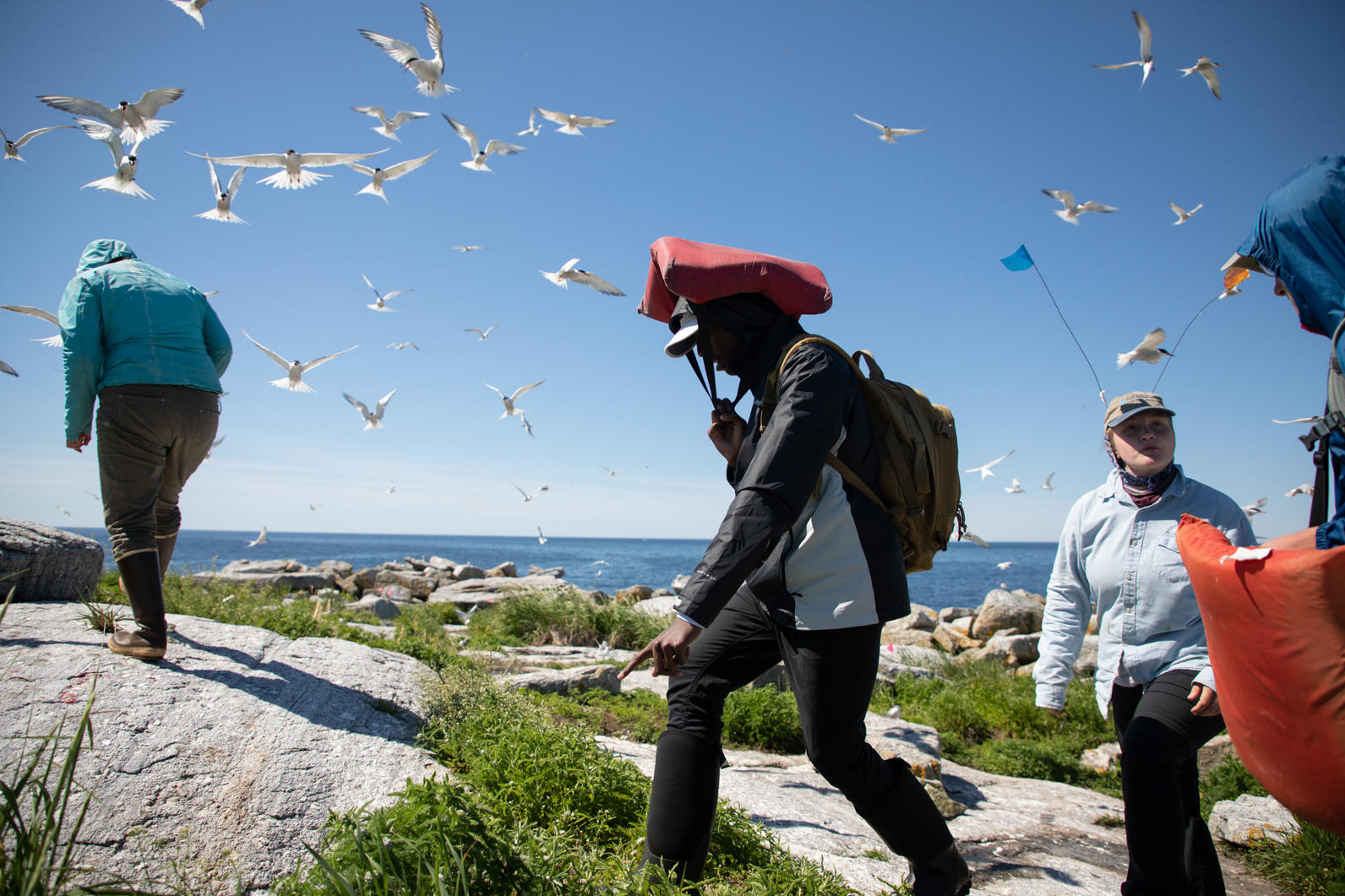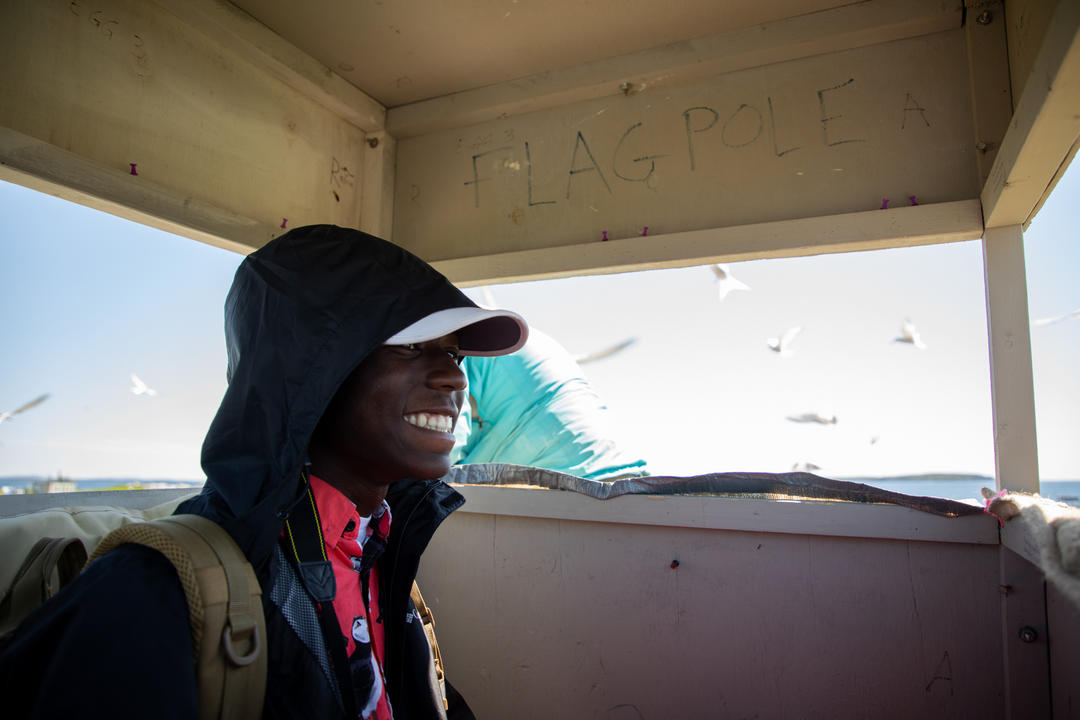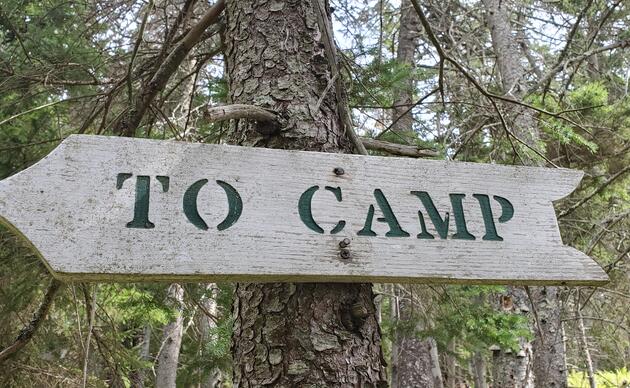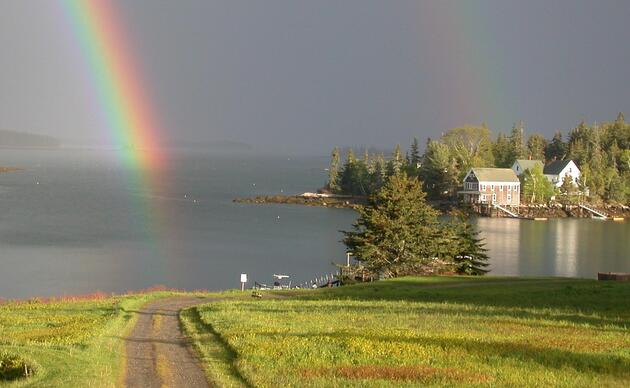This summer Georgia Ornithological Society and Ogeechee Audubon Chapter came together to award a scholarship to a young birder from Savannah, Isaiah Scott. Isaiah attended the Coastal Maine Bird Studies for Teens camp at Hog Island and was well known for his enthusiasm, charm and good birding skills. Later in the summer a donor came forward that wanted to donate her Swarovski scope to the Friends of Hog Island for them to award to a young birder. Instantly, Isaiah came to mind as a worthy recipient. Isaiah not only was a wonderful camper at Hog Island but his passion for birds extended to bird walks that he gave back in his local Georgia community. Hog Island reached out to Georgia Ornithological Society to seee if they would provide a matching tripod donation to the gift. The plan was hatched and set into motion.
Bob Sargent from Georgia Ornithological Society provided the following report of how the scope was presented:
We presented the scope and tripod to Isaiah at a meeting of the Ogeechee Audubon Society (OAS) in Savannah on the night of December 10th. Attached you'll find a photo of Isaiah and his parents (Sonja and Roger) posing with the scope, and a photo of, from left to right, me, Isaiah, Leslie Weichsel (president of OAS), and Larry Carlile (president of the GA Ornithological Society [GOS]). Isaiah had no idea that he was going to receive the scope and in fact held the door open for me as I walked into the meeting room with the scope and tripod balanced on my right shoulder. His parents were in on the secret.
Leslie led off the presentation by praising Isaiah, his devotion to birding and teaching, and the special young man that he has become. Then I talked about meeting Isaiah for the first time last January, the scholarship he received courtesy of GOS and OAS to attend Hog Island last summer, and I read a portion of the article Isaiah wrote about that amazing experience. I then explained how the scope donation happened--the partnership among FOHI, National Audubon Society's Hog Island Audubon Camp, GOS, and OAS--and read the letter you sent. Larry finished the presentation by also proclaiming how impressed he is with Isaiah's character and his accomplishments.
Isaiah sort of levitated to the microphone from his seat in the back of the room, a huge smile on his face. His mother later told me he was so thrilled she thought he was going to cry. He profusely thanked everyone involved in making the donation happen, particularly the generosity of FOHI, and spoke about how meaningful the Hog Island Camp was to him. I'm pretty sure you'll be hearing from him soon.

Here's the wonderful article written by Isaiah Scott about his week at Hog Island. Printed with permission of Georgia Ornithological Society.
The brisk, cold water swirled with bits of tangling algae, shell fragments, and rare sea glass. The cobalt waves beat rhythmically against the aged, dark boulders, which stubbornly cling to the coniferous islands. Dense, moist woodlands, overgrown with bright-green moss, concealed delicate lady’s slippers waiting to be discovered. The vast, serene grasslands with golden reeds and wildflowers swayed in unison with the coastal breeze. Glittering lakes and picturesque ponds are home to an array of chattering aerialist. Growing up in south Georgia, I never knew that I would venture to a place like this, a place called Hog Island.
On June 8th, my mom and I arrived in Portland, Maine. As soon as we spotted lighthouses in the distance from the foggy airplane window, I knew it was different from anywhere that I have ever been. We drove to Rockland and did some exploring along the way, including stuffing my mouth with a savory lobster sandwich and guzzling down a blueberry soda. We explored Owl Head Sanctuary just to get a feel of the Maine outdoors. After chasing a Red fox down a steep wooded trail, exploring the tide pools, and seeing new bird species, I was exhilarated about what tomorrow would bring on Hog Island.
On June 9th, I arrived at the Hog Island Camp Center. It was time to head to the island, to which we rode on a small boat. Hogg Island had a small dock with several wooden buildings. In the center was a neat bird garden, where I was greeted by Ruby-throated Hummingbirds, American Goldfinches, and Red-breasted Nuthatches. I soon met other campers as well as the staff. We socialized and birdwatched until we were summoned by a large bell for our first meet and greet. We played games and activities to get to know each other until it was time for dinner. The food was already set on the table, but we had to wait to be seated until the inspirational quote was said. The food was delicious, from chicken raised exclusively for Hog Island campers to wild-caught lobster. We were then assigned napkins, which we reused throughout the week. After dinner, the person seated at the end cleaned the table. When the day was over, I knew that the rest of the week would be life changing.
June 10th was the first full day at camp. Every morning, we took a short hike. The cool, moist air and fog surrounded us as we listened to Pileated Woodpeckers and Northern Parulas. Later that day, we went on an inshore boat excursion, seeing Common Eiders, Loons, Guillemots, and Harbour seals, which I’d never seen before. After the trip, there was a presentation about seabird conservation and the Puffin Project. We then returned to the mainland and drove to the Great Salt Bay Farm wildlife reserve, seeing Bobolinks, Marsh Wrens, Red-wing Blackbirds, turkeys, and a muskrat. After experiencing the pristine fields and marshes, we returned to the island, waiting for the next adventure.
On June 11th, we drove to a forest habitat in the mountains. Since it was humid and foggy, we were violently attacked by mosquitos. We came upon a bog habitat and found pitcher plants snuggled in the dense red peat. Many species of warblers were found, including Nashville Warblers, Bay-breasted Warbler, and Canada warbler.
June 12th was our big day on Eastern Egg Rock. Because this was an important site for nesting seabirds, we practiced stepping over eggs prior to our trip. Furious Arctic terns dove at our heads as we calmly passed through the nesting sites. We sat in blinds, getting an astonishing view of the birds on the gigantic rocks. We saw razorbills, puffins, Roseate Terns, Common Terns, Spotted Sandpipers, Storm Petrels, and a Peregrine Falcon. This was truly the highlight of the whole trip.
On June 13th, the last day, we explored Hog Island even more, hiking its mossy paths through the prehistoric ferns and enormous trees. We were assigned to walk a distance from each other, drawing what we heard on the trail. Calls of nuthatches and Golden-crowned Kinglets rang in my ears. We then visited a cabin in the midst of the forest, where an artist takes residence, painting the scenery or creating other works of art. Later that day, we set up large nets for bird banding, catching a Blue Jay and a Downy Woodpecker.
On June 14th, I had to say farewell to my new friends and family and depart separate ways. I am forever changed.










